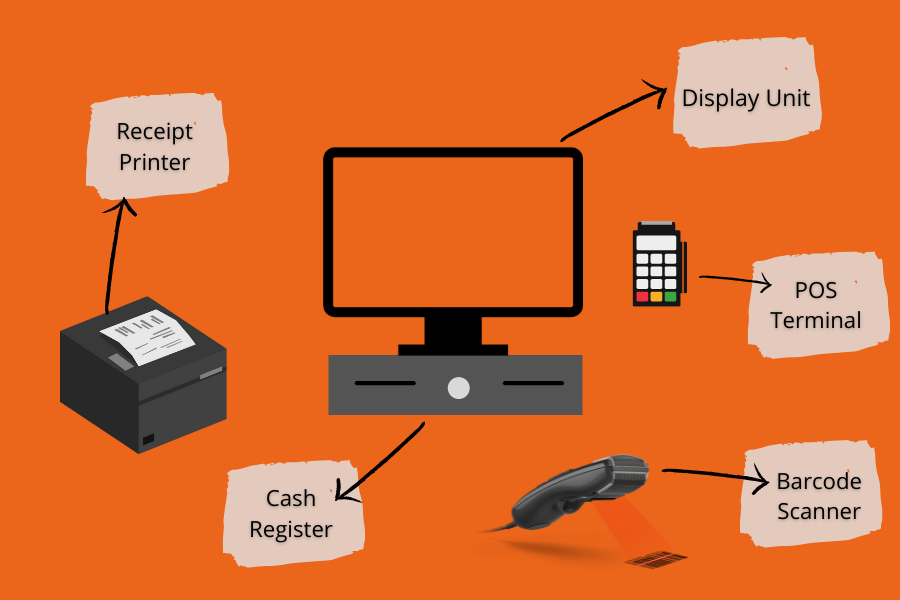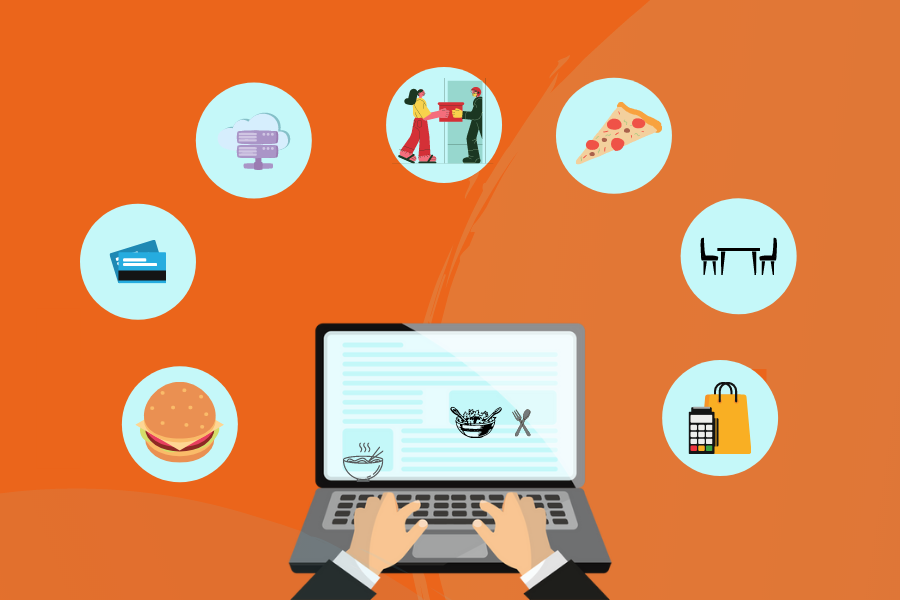Have you ever wondered why restaurants are successful? Efficient operations are the key to success for restaurants. To make business operations efficient you need to rely on technology as well. Restaurant management systems like point of sale (POS) software can keep your business efficient. The truth is that the need for a restaurant point of sale is huge because restaurants are busy businesses.
The advent of technology has revolutionized the restaurant industry as a whole. The influx of items like online ordering and digital payment has increased profits and given a new experience to the customer.
The restaurant industry during Corona Pandemic also suffered a significant downturn, but many restaurants survive those situations by looking at it as an opportunity. They expand their business online.
So why do you need to invest in a POS?
A Restaurant POS system can help you to expand your business online. It helps you to manage both online and offline sales, inventory, payment, customers, employees, and more. for better expansion, you can go for aggregator integration.
In short, the system keeps your entire business efficiently. Let’s dive deeper.
What is a Point Of Sale?
The point of sale (POS), a vital part of a point of purchase, is the location where a consumer makes a payment for products or services, as well as where sales taxes may be due. In a business that allows you to sell physical products, conduct checkouts, process orders, and pay bills.
What is a Point Of Sale System in a Restaurant?
The restaurant’s point of sale system, often known as a POS system, is a combination of hardware and software that manages workflows and transactions in food and beverage establishments. The restaurant POS system is used by food trucks, cafes, and all types of restaurants, small and large.
Related: Types of POS systems
What is a Point Of Sale Software?
Point of sale (POS) software is the operating system of the terminals. It’s an operating system just like Android and iOS on your smartphone. The point of sale system that performs transactions at restaurants is known as restaurant POS software.
POS, a restaurant, lowers physical activity and streamlines operations by providing stock and inventory control, customer relationship management, smart reporting and analytics, and much more. Furthermore, integrations with a variety of third-party apps such as online ordering, e-wallets, table bookings, loyalty programs, and so on, transform the restaurant POS machine into an end-to-end restaurant management solution.
Common Restaurant POS Software Features
Know the Features of POS software. In fact, the POS software should include all the features below.
Payment
Every time a customer buys an item your POS system needs to process the transaction. This is one of the main functions of POS software. The system helps you to simply process your payment transactions. Simple billing will give the customer a whole new experience.
POS systems may accept a variety of different payment methods.
- Cash
- Cheque
- Magstripe credit cards
- Chip cards
- Contactless payments
- UPI
Inventory Management
POS software makes managing inventory management easier. Keeps track of every item of your inventory and get notification when stock goes low.
Inventory Management Features.
- Import items – Upload thousands of items using CSV spreadsheets
- Track inventory – Keep track of product and component stock.
- Purchase Order Receiving – With Purchase Order Receiving, you may increase profitability by preventing supply shortages.
- Product variants and composites
- Low stock notifications – Receive daily alerts at low stock levels so you can place essential item purchases on time.
- Transfer orders – Create transfer orders and product transfers between your locations with ease.
- Auto-Refill Orders – When a product falls below your predefined level, it automatically generates stock orders.
POS Reports
With POS reports you analyze your business performance and take business desecions according to the data.
These are some of the most typical reports generated by restaurant point-of-sale software.
- Sales trends – Monitor sales growth or declines in comparison to the preceding day, week, or month, and respond quickly to any changes.
- Popular items – This enables you to identify the best-selling items so that you can make informed purchasing selections.
- Shifts – Identify the cash shortage at the end of the shift and keep note of any inaccuracies or manipulations by employees.
- Tax report – Analyze reports to determine the amount of tax that has to be paid and save time.
- Inventory Reports – Get inventory reports
- Sales Reports – Get sales report
Customer Loyalty
To identify your most loyal customers, look at the number of visits and the amount of money they spent. All qualifying purchases earn customer loyalty points, which they can use in the future. On the payment screen, staff can see the customer’s balance and apply it to the transaction.
Loyalty program with the restaurant point of sale software that includes these features
- Customer database – Analyze the number of visits and purchases to determine who your most devoted consumers are.
- Loyalty Point Rules – You can offer a single basic loyalty reward rate for all products, or use special rates for unique items.
- Redeeming loyalty rewards – All qualifying purchases earn customer loyalty points, which they can use in the future. On the payment screen, staff can see the customer’s balance and apply it to the transaction
- Know your top customers – Know who your most loyal customers are and how they spend their money.
- Loyalty App – Keep your consumers happy by delivering them personalized offers and updates.
Create customer loyalty techniques to increase sales with this feature.
Online Ordering
It can be said that online deliveries have saved restaurants in the Corona Pandemic. Contactless delivery is one reason for this. POS software can help you grow your online business using your online platform or integrate with third-party aggregators.
Restaurant POS Hardware

Hardware that contains the original components of the system – The part of the system that you can see and touch is called the POS hardware. Examples of restaurant POS hardware include credit card readers, receipt printers, mobile wallet readers, POS scales, customer-facing screens, cash drawers, and barcode scanners.
Compulsory Restaurant POS Hardware
POS Terminal
You need hardware to run the POS software. This is the most important part of the restaurant POS hardware. Employees may manage transactions using the POS terminal, which is an electronic device and offers a digital interface.
POS terminals are usually desktops, laptops, iPads, tablets, or smartphones. In restaurants, iPads and tablets are commonly used. They have bigger screens than smartphones. So that servers can view all they require at the same time. Also, because it is lightweight and easy to use, restaurant staff can carry it from table to table.
The POS terminal is one of the most expensive components of a restaurant’s point-of-sale system. So make sure you use the POS software of your choice on your hardware. Or you need to find a POS provider that can be used on existing hardware.
Printers
everything has gone digital and print receipts are still in use. Although digital invoices can be forwarded to things like email, some use printed receipts. That’s why printers are so important in restaurant hardware. Impact printers and thermal printers are the two most prevalent types of receipt printers.
Barcode Scanner
Barcode scanners are mostly used in retail establishments. However, scanners are used to make restaurant operations faster and easier. And this is especially important for restaurants that offer pre-prepared foods or items.
Barcode scanners also help to manage inventories efficiently, speed up the checkout process, and scan from the register, table, or order screen. As mentioned earlier in the terminal, make sure the barcode scanner is compatible with your specific POS software.
Payment Terminals
In recent years, the manner diners pay has changed considerably, particularly in the aftermath of the COVIID-19 epidemic, as have the payment systems used in restaurants. After the COVID-19 outbreak began in March 2020, a stunning 40% of restaurant owners reported they had embraced contactless or mobile payments.
Payment terminals are required to make payments using things like credit cards. Remember that if you can offer different payment options and methods to your customers, it will give them a new experience.
Kitchen Display System (KDS)
The Kitchen Display System is also known as the Kitchen Order System. Kitchen Display Systems (KDS) is a backend ordering and information system that enables restaurants to operate more efficiently. The KDS system is connected to the cloud-based POS system, which allows them to work remotely and display orders when they enter the POS software.
Cloud-Based Restaurant Point of Sale
Cloud-based restaurant point of sale allows you to access all information from a remote server instead of storing and accessing it locally. The advantage of this is that you do not have to enter the restaurant premises to access the data. With the help of the internet, you can check the data through a browser from anywhere and manage the business as a whole.
Benefits of Cloud-Based Restaurant Point of Sale
- Cost-Effective
- Insights to Increase Profitability
- Risks are kept to a minimum, and the profits are multiplied.
- Get Real-Time Updates
- Accountability
- Lower Labor Costs
- Inventory Evaluation
Related: more about Cloud Restaurant POS


3 replies on “Everything You Need to Know About Restaurant Point of Sale (2022) Definitions, Hardware, Types and more”
[…] Restaurant point of sale […]
[…] Restaurant point of sale […]
[…] Everything you need to know about restaurant point of sale […]